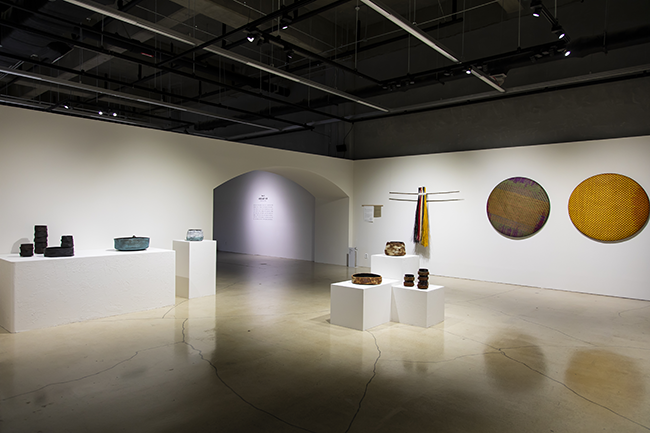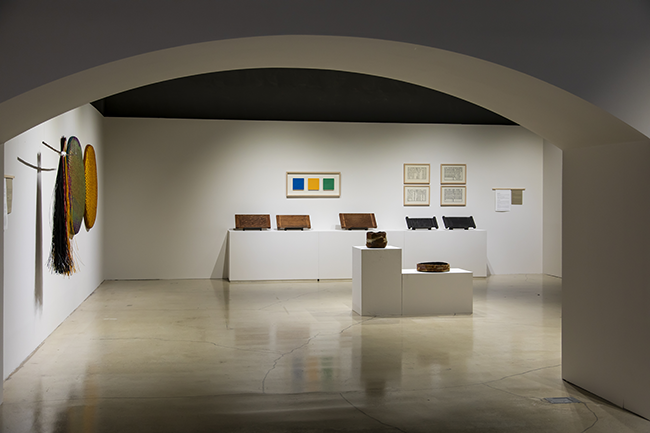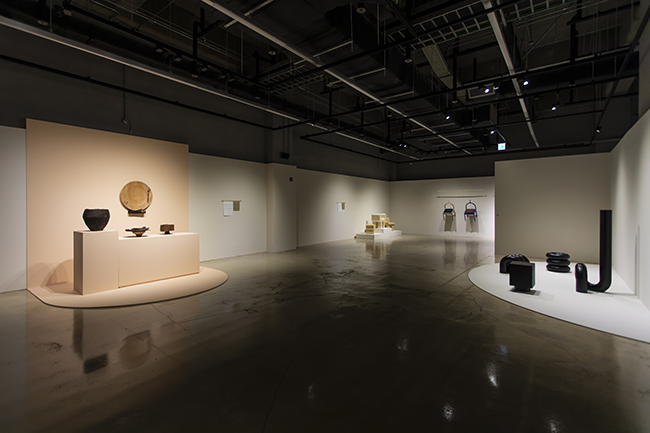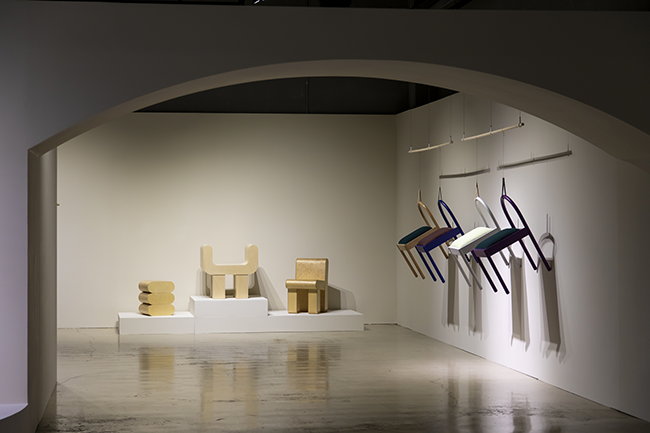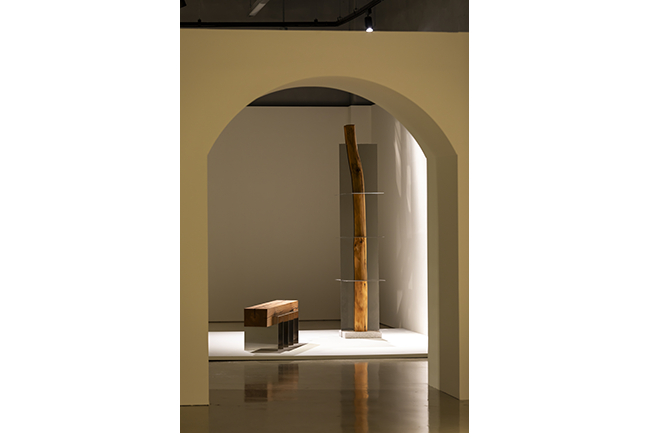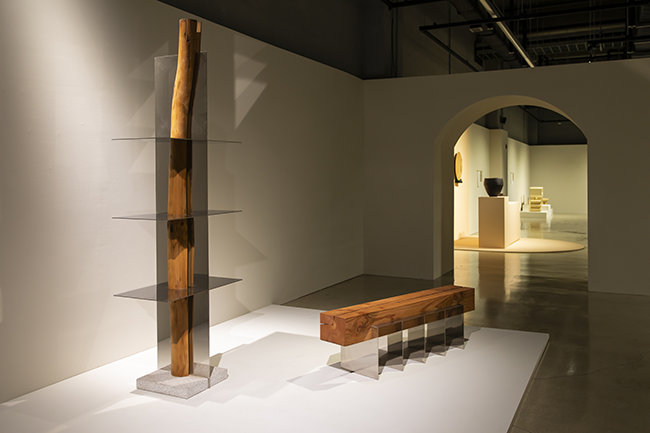
전시영상
공예의 숲
아마 앞으로도 그럴 것입니다. 그러다 보니 나무는 아주 아주 오래전 인간이 동굴 속에서 손으로 무언가를 만들기 시작할 때부터
가장 손쉽게 구할 수 있던 재료였습니다. 불을 지피기 위한 땔감, 나무배, 종이에 이르기까지 그야말로 인간과 가장 밀접한 재료이자 예술의 도구였습니다.
이처럼 인류의 역사를 함께 해온 나무는 베어졌음에도 나무의 성질을 잃지 않고 여전히 수축 팽창을 하여 자연, 생명에 대한 영감을 줍니다.
또한 우리의 주거 공간에 놓이는 가구를 만드는데 자주 쓰이기 때문에 건축적인 면을 갖춘 특별한 공예입니다. 그래서 나무를 연구하고 다루는 작가들은
자연스레 나무를 거대한 자연의 모습, 도시 공간을 이루는 건축으로 담기도 하고, 그것을 깎고 다듬는 고된 노동 시간을 절제와 무위의 과정으로
받아들이기도 합니다. 그렇게 나무는 살아있는 자연과 우주, 그리고 그 안에 살아가는 인간의 모습과 많이 닮아 있습니다.
이번 전시 《공예의 숲》은 오랜 세월 인류와 함께해 온 나무를 다루는 작가들의 작품을 세 파트로 구성하여 기획하였습니다. ‘지혜로운 뿌리’에서는
자연과 생명의 근원을 표현한 나무 작업과 옛 선조들로부터 이어온 장인들의 작품을 선보입니다. 두 번째 파트 ‘사람을 닮은 나무’에서는
살아 숨 쉬는 나무와 소통하는 작가들, 그리고 그 본질에 대해 사유하는 작품들이 펼쳐집니다. 마지막 ‘공예의 숲’에서는 나무가 모여 이룬 숲이라는 공간에서
작가들이 사유한 다채로운 세계관을 만날 수 있습니다.
이번 전시를 준비하며 만난 작가들 12명 모두에게 좋아하는 나무, 혹은 자주 쓰는 나무가 무엇인지 물었습니다. 참 신기하게도 12명의 작가 모두 대답과
이유가 달랐습니다. 각자의 시선으로 나무를 바라보고 사유하며, 자신의 삶과 철학이 녹아있는 작은 숲을 저마다 가꾸고 있었습니다.
작가들이 키워 온 작은 숲에서 여러분들만의 공예의 숲을 만끽하는 기회가 되시길 바랍니다.
English ver...
Woods of Crafts
so trees have been around much longer than humans and will probably continue to do so when we are gone.
That means, quite naturally, wood has been the most readily available material ever since humans began making things
with their hands in caves a long, long time ago. From firewood for starting a fire, to wooden boats and paper,
wood was the material most closely involved in human life and also a tool of art.
This way, woodcraft, which has long been a part of human history, does not lose the inherent properties of wood even
when it is cut down, and still expands and contracts, providing inspiration for nature and life. It is also a special
form of craft with an architectural aspect because it is often used to make furniture and fittings for living spaces.
As such, artists who study and deal with trees naturally include trees as a gigantic form of nature or architecture
that forms urban spaces, and they also accept the arduous labor of cutting and trimming wood as a process of
moderation and non-action. Like so, trees have a close resemblance to living nature, the universe, and us humans who reside
on this particular planet within the cosmos.
This exhibition, Woods of Crafts, is organized into three parts featuring works by artists dealing with trees,
which humanity has lived with for a long time. Part 1, “Wise Roots,” showcases woodcraft that expresses nature and
the source of life, as well as the works of artisans passed down from our ancestors for generations. Part 2, “Human-like Trees,”
includes works by artists who communicate using living, breathing trees and art pieces that ponder the true essence of things.
In the final part, “Woods of Crafts,” you can get a glimpse into the colorful worldview of the artists in a space called
“woods” where trees are packed together.
The Museum asked all twelve artists while they were preparing for this exhibition what their favorite tree was or
what type of wood they often used. Interestingly enough, all twelve artists gave different answers and reasons.
Each person looked at and thought about trees from their own perspective, and each was keen on cultivating a small forest
that contained his/her own life and philosophy. We hope our exhibition gives you the opportunity to enjoy your own
Woods of Crafts with each small and sophisticated forest made by our artists.
참여작가
PART 1. 지혜로운 뿌리
자연과 생명의 근원을 표현한 나무 작업과 옛 선조들로부터 이어온 장인들의 이야기입니다.
안문수 작가는 한 점으로부터 시작한 나무줄기를 거대한 토네이도로 변화시켜 대지의 에너지를 표현하고,
강석근 작가는 고즈넉한 목물(木物) 속에 자연의 흙과 태양, 모래와 바람을 담아냅니다. 각자장 박영덕 장인은
오랜 세월 헌신으로 갈고 닦은 섬세한 손길로 아름다운 목판을 완성하고, 대나무를 다루는 서신정 장인은
실과 같이 얇은 대나무로 경이로운 자연의 아름다움을 보여줍니다.
PART 1. Wise Roots
A story of woodcraft that expresses nature and the source of life,
as well as the works of artisans passed down from our ancestors for generations.
Artist An Moonsu expresses the energy of the Earth by transforming a tree trunk
that starts from a single point, and then turns into a massive tornado.
Artist Kang Suk-keun captures the earth, sun, sand, and wind from nature in what seems
like a serene wooden object. Meanwhile, artisan Park Youngdeok has created beautiful woodblocks,
delicately crafted with techniques he honed over many years, and artisan Seo Sinjeong,
who works with bamboo, shows the wondrous beauty of nature with bamboo that is as thin as a thread.
-

안문수
An Moonsu
-

박영덕
Park Yeongdeok
-
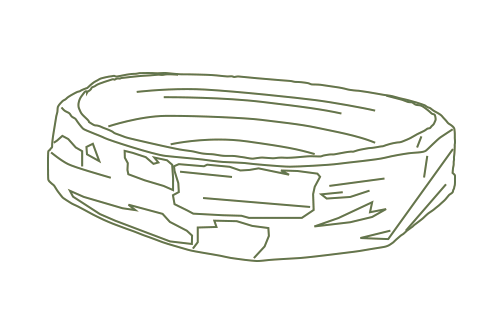
강석근
Kang Suk-keun
-
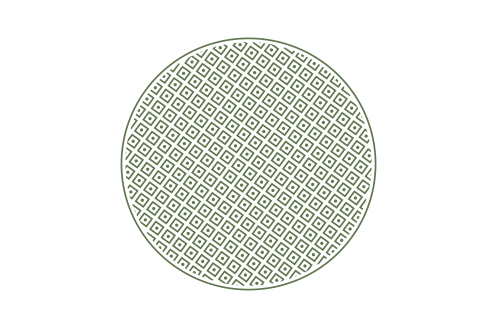
서신정
Seo Sinjeong
PART 2. 사람을 닮은 나무
살아 숨 쉬는 나무와 소통하는 작가들, 그리고 그 본질에 대한 사유를 살펴보고자 합니다. 작가들은 자신만의
방법으로 나무와 교감하고, 사람의 모습을 많이 닮은 나무로부터 깨달음을 얻습니다. 노경택 작가는 나무들의
살아있는 신호들을 포착하여 교감을 꾀하고 식물을 위한 가구를 만듭니다. 젊은 목공예가 이상훈 작가와 이채영 작가는
아름다운 기하학적 곡선의 가구에서 나무의 본질에 다가서려 합니다. 김민욱 작가는 나무 역시 사람처럼 각기 다른 본성이 있다고
여겨 나무 고유의 형태와 결, 무늬로 그 고유의 감성을 끄집어내려 합니다.
PART 2. Human-like Trees
Takes a look at artists who communicate with living, breathing trees,
and their thoughts on what is essential. Artists commune with trees in their own ways
and seek enlightenment from trees that resemble humans in many ways. Artist Roh Kyungtaek
captures the living signals of trees to encourage communion with trees and he creates
furniture specifically for plants. Young wood artists Lee Sanghoon and Lee Chaeyoung attempt
to get closer to the essence of wood through furniture adorned with beautiful geometric curves.
Artist Kim Minwook believes that trees, like people, have different natures to them and thus,
he tries to bring out their unique sensibilities through their distinct shapes, textures, and patterns.
-

노경택
Roh Kyungtaek
-

이상훈
Lee Sanghoon
-
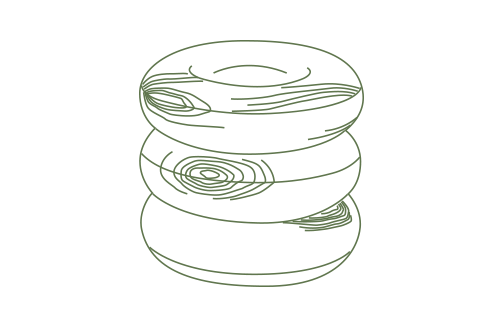
이채영
Lee Chaeyoung
-

김민욱
Kim Minwook
PART 3. 공예의 숲
나무가 모여 이룬 숲이라는 공간에서 작가들이 사유한 다채로운 세계관을 만납니다.
이자연 작가는 닥나무 한지로 붉은 숲을 만들어 그 숲에 들어서는 관람객들에게 복잡 미묘한 감정의 풍경을 선사합니다.
황명수 작가는 서로 다른 숟가락들에 인간의 삶과 죽음, 그리고 인생을 담습니다. 김은학 작가는 기하학적인 가구들에
규칙을 부여해 작가가 창조한 새로운 가상 도시를 만들고, 손신규 작가는 옛 한옥 고재에 상반되는 스테인리스를
더해 건축적인 가구를 완성합니다.
PART 3. Woods of Crafts
In the woods made up of trees, the audience can meet the diverse worldviews
presented by the artists. Artist Lee Jayeon presents a red forest with Paper Mulberry and
creates a landscape of complex and subtle emotions for visitors who enter the woods.
while artist Hwang Myungsoo captures the life, death, and story of people in different spoons.
Artist Kim Eunhak builds a new virtual city by imposing rules on geometrically shaped furniture,
and Shon Shinkyu exhibits some architectural furniture with stainless steel additions,
which is quite the opposite of old trees from Hanok houses.
-
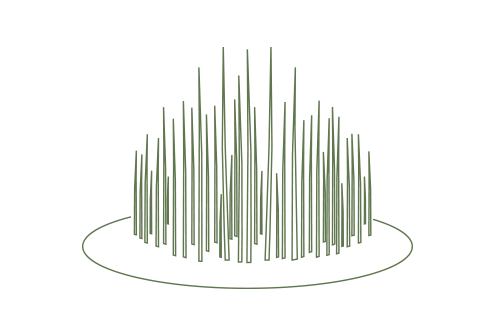
이자연
Lee Jayeon
-

김은학
Kim Eunhak
-
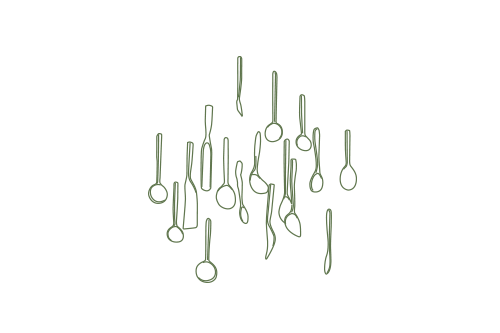
황명수
Hwang Myungsoo
-
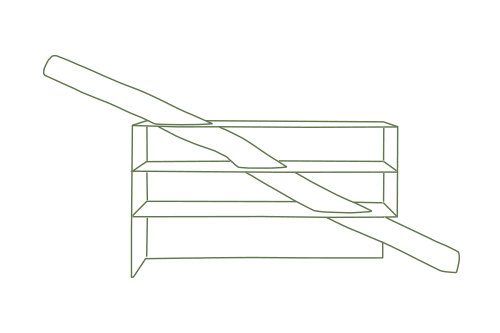
손신규
Shon Shinkyu
Credits
-
2024 상반기 기획전
<공예의 숲>기간2024. 4. 2.(화) ~ 2024. 6. 2.(일)
장소청주시한국공예관 갤러리 3
주최청주시
주관청주시문화산업진흥재단
청주시한국공예관
시장이범석
관장변광섭
학예실장안승현
학예팀도경민, 이들닙, 김지윤, 유민우
스튜디오최효민, 이진아
교육최효민, 김시연, 이진아
시설박용식
홍보김시연
뮤지엄숍김경희, 김성란, 박수은
충청북도 청주시 청원구 상당로 314
문화제조창 본관 3-4층
Tel. 043-219-1800
www.cjkcm.org
-
전시
총괄변광섭, 안승현
기획도경민
진행도경민, 이들닙, 김지윤, 유민우
교육이들닙, 김시연
시설박용식
홍보김시연
온라인전시
기획도경민
제작웹플러스존
그래픽디자인홍새아, 디자인팩토리
영상로그아트
사진더레이스튜디오
번역(주)피엘씨웍스
협력
공간디자인-시공(주)야탑
운송㈜큐비스아트
-
2024 Wood Craft Art Exhibition
Woods of CraftsPeriod2024. 4. 2.(TUE) ~ 2024. 6. 2.(SUN)
locationGallery 3, Korean Craft Museum
HostCheongju City
OrganizerCheongju Cultural Industry Promotion Foundation
KOREAN CRAFT MUSEUM
MayorLee Beomseog
DirectorByeun Kwangsub
Chief CuratorAn Seunghyun
CuratorDo Kyeongmin, Lee Deulnib, Kim Jiyoun, You Minwu
StudioChoi Hyomin, Lee Jina
EducatorChoi Hyomin, Kim Siyeon, Lee Jina
FacilitiesPark Yongsik
PRKim Siyeon
Museum ShopKim Kyounghee, Kim Seongran, Park Sueun
Culture Factory, 314 Sangdang-ro,
Cheongwon-gu, Cheongju-si,
Chungcheongbuk-do,
Republic of Korea
Tel +82-43-219-1800
www.cjkcm.org -
Exhibition
SupervisorByeun Kwangsub, An Seunghyun
CuratorDo Kyeongmin
CoordinatorDo Kyeongmin, Lee Deulnib,
Kim Jiyoun, You MinwuEducatorLee Deulnib, Kim Siyeon
FacilitiesPark Yongsik
PRKim Siyeon
Online Exhibition
PlanningDo Kyeongmin
Site BuildingWebpluszone
Graphic DesignHong Saea, Design Factory
VideoLogArt
PhotoThe RAY Studio
TranslationPLC Works
Cooperation
Space Design·ConstructionYATOP Co.,
TransportationQbis Art Co.,
![]()
- 안문수 An Moonsu
-
<끝과끝>은 그동안 작가가 이어온 우주와 자연에 대한 관찰의 연장선에 있는 작업이다. 이전 작업 <윈터 Winter> 시리즈에서 겨울이 생명의 끝과 사라짐이 아닌, 자연 본연의 모습이 그대로 드러나는 순간이었음을 발견하였다면 이번 신작 <끝과끝>은 그러한 <윈터> 시리즈 너머의 이야기이다. 겨울은 결국 끝이 아니고 또 다른 시작의 순환인 것이다.
가느다란 나무 한 줄기로 시작되는 이번 작업은 이러한 작가의 집요한 사색이 집약된 설치 작품이다. 작은 한 점에서 시작된 나무줄기는 에너지를 함축한 거대한 토네이도가 되었다가 다시 한 점으로 귀결한다. 결국 작은 것과 큰 것은 연결되어 순환하고 거대한 지구, 우주, 대자연 역시 그러하다.
Artist’s Favorite
흑단 (Ebony)
예리하고 극에 달하는 작업 방식을 좋아하는 안문수 작가는 나무로 표현할 수 있는 한계점까지 작업을 끌어갈 수 있는 흑단을 좋아한다. 돌 같은 나무로 유명한 흑단은 나무가 물에 가라앉아 버릴 정도로 쇠 같아 어지간한 도구로 깎기 힘들다. 작가는 그런 밀도 높은 나무에 디테일한 묘사를 하는 것을 좋아한다. 무른 나무에서는 표현이 안 되는 단단한 나무를 세밀하게 조각했을 때의 그 한계치에서 오는 아찔한 형태를 작품에 담고자 한다.
“END AND END” is an extension of the artist's observations of the universe and nature. In his previous “Winter” series, An Moonsu discovered that winter is not the end nor the perishing of life, but rather a moment in time when nature revealed its naked self. “END AND END” takes the artist beyond this "Winter" series. Winter, instead of being the end, is part of a cycle and a new beginning.
“END AND END,” which begins with a thin tree trunk, is an installation art piece that purports to be the culmination of the An’s persistent contemplation. The tree trunk sprouting out from a small point goes on to become a sizable tornado with massive energy, but then ends up feeding into a small point again. Ultimately, everything circulates as small things are connected to larger things, and the same is true for our whole planet, the universe, and Mother Nature.
Artist’s Favorite
Ebony
As an artist, An Moonsu prefers a sharp and extreme work style. He likes ebony, which allows him to push his work to the absolute limit of what can be expressed with wood. Ebony, famous for its stone-like hardness, is difficult to carve using ordinary tools since the wood is so dense like iron - it even sinks like iron in water. Nevertheless, the artist often carves various details into this dense piece of wood. In “END AND END,” An seemingly wants to capture the breathtaking form that emerges when pushing a hardwood like Ebony to the limit and carving things into the surface, which is an impossibility with softer wood. -
![]()
- 운봉雲峰 박영덕 Park Yeongdeok
-
각자장(刻字匠)은 옛날 대량의 서적 인쇄를 위해 목판을 만들거나, 궁궐과 사당 등의 현판에 글자를 새겨놓은 일을 담당한 장인을 말한다. 박영덕 작가는 충청북도 무형문화재 제28호 각자장으로 1988년 서각에 입문해 1996년 충북 보은군에 <운봉서각원>을 열고 책판 제작에 매진해 왔다.
2015년 대한민국 전승공예대전에서 <훈민정음언해본 책판 및 능화판>으로 대통령상을 받은 바 있으며, 매년 서울대학교 규장각에서 희귀 고서 복원 의뢰를 받아 우리나라 옛 서각 복원에 힘쓰고 있다.
* 능화판(菱花板) - 책 표지에 다양한 무늬를 넣기 위한 목판을 말한다.
* 사격뇌문(斜格雷文) – 네모 모양이 달팽이 식으로 이어지는 것을 말하며, 마름모꼴의 번개무늬를 말한다.
* 회자문(回子紋) - 큰 네모 안에 작은 네모, 즉 회(回)자 모양의 문양을 말한다.
* 훈민정음 해례본(解例本)과 언해본(諺解本) - 훈민정음 해례본은 조선 4대 왕 세종대왕이 훈민정음을 만들고 이를 한문으로 해설하여 쓴 책이다. 이후 조선 7대 왕 세조에 이르러 한문을 모르는 백성들이 한글을 쉽게 이해하고 사용할 수 있도록 순수 우리말 해설서가 나오는데, 이를 언해본이라고 한다.
Artist’s Favorite
산벚나무 (Cherry), 자작나무 (Birch)
서각을 위한 목판은 재질이 균일하고 나무를 이루는 세포의 크기가 작아 글자를 새기거나 종이에 찍었을 때 깨끗하게 나와야 한다. 적당히 연하고, 적당히 단단해야 하며, 세포의 크기도 고른 나무가 산벚나무와 자작나무이다. 산벚나무와 자작나무는 예부터 목판 인쇄를 위해 사용됐으며, 해인사의 팔만대장경도 이 나무로 만들어졌다.
A “Gakjajang (刻字匠)” refers to an artisan entrusted to create woodblocks used for printing large volumes of old books in the past, or engraving letters on plaques hung outside royal palaces and shrines. Artist Park Yeongdeok, a Gakjajang officially registered as the 28th intangible cultural heritage of Chungcheongbuk-do, began learning the art of Seogak in 1988, then opened Unbong Seogakwon in Boeun-gun, Chungcheongbuk-do, in 1996. Ever since, he has devoted himself to producing woodblocks for printing.
In 2015, Park received the Presidential Award at the Korea Annual Traditional Crafts Art Exhibition for his “Hunminjeongeum Eonhaebon Chaekpan and Neunghwapan.” Each year, Park is commissioned by Seoul National University's Gyujanggak to restore rare old books, and he works relentlessly on restoring old Korean books.
* Neunghwapan (菱花板) - A woodblock used to add various patterns to book covers.
* Sagyeoknoemun (斜格雷文) – A pattern of squares arranged in a snail pattern; refers specifically to a diamond-shaped lightning pattern.
* Hoejamun (回子紋) - A pattern with a small square within a large square, creating a shape that looks similar to the Chinese character for “hoe (回).”
* Hunminjeongeum (解例本) and Eonhaebon (諺解本) - Hunminjeongeum Haeryebon was written by King Sejong the Great, the 4th monarch of the Joseon Dynasty, who created the Hangeul writing system. The book is a commentary on the Hunminjeongeum that explains, in Chinese characters, how this new writing system works. Later, during the reign of King Sejo, the 7th monarch of the Joseon Dynasty, a pure Korean language version of commentary called the Eonhaebon was published so that people who did not know how to tread Chinese characters could easily understand and use Hangeul.
Artist’s Favorite
Cherry, Birch
Woodblocks used for Seogak must be made of a material that is consistent in quality and the cells that make up the wood should be smaller in size so that the final product (i.e. Book) comes out cleanly when engraved or stamped on paper. Thus, moderately soft or moderately hard wood with cells in size across the board, like Cherry or Birch, are often chosen for woodblocks. In fact, Cherry and Birch trees have been used for woodblock printing since ancient times. Most notably, the Tripitaka Koreana at Haeinsa Temple was made using these two types of trees. -
-
이전 다음
-

훈민정음 언해본 Hunminjeongeum Eonhaebon, 2015, H260×W540mm,
산벚나무 Cherry -

Detail_ 훈민정음 언해본 Hunminjeongeum Eonhaebon
-

훈민정음 해례본 Hunminjeongeum Haeryebon, 2015, H260×W540mm,
산벚나무 Cherry -

Detail_ 훈민정음 해례본 Hunminjeongeum Haeryebon
-

훈민정음 언해본·해례본 인출본
Print of Hunminjeongeum Eonhaebon•Haeryebon, 2024,
H355×W485mm, 한지 Hanji -

능화판(사격 운문양) Neunghwapan, 2022, H325×W630mm,
산벚나무, 옻칠 Cherry, ottchil -

Detail_ 능화판(사격 운문양) Neunghwapan
-

능화판(사격뇌문 마름모 능화) Neunghwapan, 2019, H325×W630mm,
산벚나무, 옻칠 Cherry, ottchil(Natural lacquer) -

Detail_ 능화판(사격뇌문 마름모 능화) Neunghwapan
-

능화판(회자문바탕 연화보상문양) Neunghwapan, 2015, H325×W630mm,
산벚나무, 옻칠 Cherry, ottchil -

Detail_ 능화판(회자문바탕 연화보상문양) Neunghwapan
-

능화판 인출본 Print of Neunghwapan, 2024, H425×W970mm,
한지 Hanji -

전시전경 Exhibition view
-
![]()
- 강석근 Kang Suk-keun
-
강석근 작가는 공예의 기본인 ‘쓰임’의 실용성을 작업의 근간에 두고, 그 위에 예술적 감성을 목물(木物)에 담는다. 그리고 이 목물(木物)에 담긴 작가의 감성은 태양, 자연, 바람에서 온다. 실제로 작가의 작업실은 자연, 바람, 태양과 가까이 있는 곳에 위치해 있기도 하다.
목기에는 작가가 5년에 걸쳐 완성한 옻칠 열경화 기법이 사용되는데, 불에 약한 목기를 200℃가 넘는 가마에서 옻칠 경화로 마무리해 견고함을 더한다.
이번 작업 ‘지구의 것(Earth’s)’ 시리즈는 흙, 광석, 돌, 모래 등을 옻칠 마키 기법(Makie-technique)으로 목기에 입히고 자연 부식한 작품이다. 작가는 목기에 옻칠을 칠하고, 옻칠이 마르기 전 자연의 재료들을 열경화로 굳히는 작업을 반복한다. 이러한 반복이 거듭될수록 자연스러운 층이 생기는데, 이런 층들은 며칠에 걸친 햇빛 노출로 부식되면서 자연 본연의 색을 만들어 낸다.
Artist’s Favorite
느티나무 (Zelkova)
강석근 작가는 느티나무가 본인과 가장 잘 맞는다고 생각한다. 느티나무는 옻칠을 했을 때 나이테 모양이 예쁘게 나오고, 조각적인 모양이 톱으로도 잘 표현된다. 단단하면서도 섬세한 표현들이 잘 되어 10년 이상 느티나무를 작업에 사용 중이다.
Artist Kang Suk-keun places the practicality of “use,” the foundation of all crafts, at the basis of his art, and he also breathes his sensual artistic spirit into wooden objects. Kang's sophisticated style imparted on these wooden objects is inspired by the sun, nature, and wind. His studio is, in fact, located close to nature, wind, and the sun.
Each wooden vessel is produced using thermally cured lacquer, a technique that Kang spent five years perfecting. To cure a wooden vessel, which is vulnerable to fire, he paints it with a layer of lacquer, then fires it in a kiln at over 200oC to make it as sturdy as possible.
Titled “Earth’s,” this series features a variety of wooden vessels coated in soil, ores, stones, sand, etc. using a lacquering “Makie” technique. Each piece is then allowed to decay naturally over time. The artist repeats the process of applying lacquer to wooden vessels and curing the natural materials added to the surface with heat before the lacquer dries. Repeating this process naturally creates multiple layers on the surface. Kang leaves each wooden vessel exposed to sunlight so that these layers erode and create more natural-looking colors.
Artist’s Favorite
Zelkova
Kang Suk-keun believes that the Zelkova tree suits him best. Lacquering a Zelkova tree brings out its growth rings beautifully, and it is easy to carve it into a sculpture using something as simple as a saw. Zelkova has been featured in Kang’s work for over a decade now since it is a great material for creating solid yet delicate expressions of art. -
-
이전 다음
-

지구의것 시리즈 Earth’s series, 2023, H210×W490×D410mm,
나무, 옻, 금속 Wood, ottchil, metal -

지구의것 시리즈 Earth’s series, 2022, ø250×H180mm,
나무, 옻, 금속 Wood, ottchil(Natural lacquer), metal -

지구의것 시리즈 Earth’s series, 2023, H90×W420×D395mm,
나무, 옻, 금속 Wood, ottchil, metal -

지구의것 시리즈 Earth’s series, 2022, ø250×H190mm,
나무, 옻, 금속 Wood, ottchil, metal -

지구의것 시리즈 Earth’s series, 2022, ø145×H190mm(×6개),
나무, 옻, 금속 Wood, ottchil, metal -

지구의것 시리즈 Earth’s series, 2023, (앞)H105×W360×D330mm,
(뒤)ø145×H85mm(×10개), 나무, 옻, 금속 Wood, ottchil, metal -

전시전경 Exhibition view
-
![]()
- 서신정 Seo Sinjeong
-
채상(彩箱)이란, 채죽상자(彩竹箱子)의 줄임말로 대나무를 종이처럼 얇고 실처럼 길게 쪼개 그 위에 색을 입혀 만든 상자를 말한다. 예부터 귀한 것들을 담아 보관하는 보석함, 혼수품에 사용되었는데, 왕에게 바치는 선물로 사용될 정도로 귀했다. 서신정 장인은 채상장 국가무형문화재였던 아버지 서한규 장인의 맥을 잇고 있다.
<해> 시리즈는 그간 해왔던 채상의 작업을 넘어 색을 입은 대나무의 결과 아름다움을 오브제 작품으로 만든 작업이다. 평소 자연의 신비로운 색의 조화를 연상하며 조색을 한다. 서로 어울리지 않을 것 같은 색들이 대나무의 결을 입고 오묘한 색으로 조화로운 빛깔을 만들어 낸다.
Artist’s Favorite
왕죽 (王竹)
왕죽은 20미터 높이의 대나무로 대나무 가운데 가장 굵다. 또한 부드럽고 유연성이 좋아 실처럼 가늘게 만들어야 하는 대오리에 적합하다. 담양 대나무는 특히 기후와 토양 덕에 대나무 품질이 좋다. 담양의 대밭은 황토밭이어서 왕죽이 자라기에 적합한 환경이며, 더운 여름과 추운 겨울의 4계절을 모두 견뎌내어 윤기가 자르르한 것이 특징이다.
“Chaesang (彩箱)” is short for “Chaejuk Sangja (彩竹箱子).” It refers to a box made by splitting bamboo as thin as paper and as long as a thread, which is then painted with color. These Chaesang boxes have been used since ancient times as jewelry cases or hope chests. In some cases, they were so valuable and therefore gifted to the king. Seo Sinjeong continues in the footsteps of her father, Seo Hankyu, who was the registered national intangible cultural heritage of Korea.
The “Sun” series by Seo transcends the more utilitarian Chaesang boxes made in the past, and elevates the texture and beauty of colored bamboo into an “objet d'art.” She typically mixes colors reminiscent of the harmony rendered through nature's mysterious colors. Colors that do not seem to match each other at first glance blend in harmony as they turn into something more mysterious when combined with the unique texture of bamboo.
Artist’s Favorite
Timber Bamboo (王竹)
Timber Bamboo grows to 20m and is the thickest among all Bamboo types. The tree is also supple and flexible, making it the perfect Bamboo to strip and spin as a thin string or thread. Timber Bamboo from Damyang-gun is of particularly good quality thanks to its climate and soil. Damyang-gun has four distinct seasons, from sweltering hot summer to bitter cold winter, which means the Bamboo grown in Damyang develops a great sheen to it as it endures severe seasonal swings throughout the year. The soil in Damyang - red clay - is also great for Timber Bamboo. -
-
이전 다음
-

밝은 해 the Bright Sun, 2024, ø1200mm, 대나무 Bamboo
-

흐린 해 the Cloudy Sun, 2024, ø1200mm, 대나무 Bamboo
-

Detail_ 밝은 해 the Bright Sun
-

Detail_ 밝은 해 the Bright Sun
-

Detail_ 흐린 해 the Cloudy Sun
-

Detail_ 흐린 해 the Cloudy Sun
-

채상 댓살 Sliced and dyed bamboo for Chaesang,
2024, L1200~1500mm, 대나무 Bamboo -

전시전경 Exhibition view
-
![]()
- 노경택 Roh Kyungtaek
-
<플랜트씨의 가구들>은 식물을 위한 가구라는 컨셉에서 시작한다. 살아있는 식물들은 가만히 있는 것처럼 보이지만 사실 향기, 냄새, 미세한 수분 입자 등 스스로 살아있다는 신호를 보낸다. 작가는 이 미세 신호들을 아두이노(Arduino)라는 작은 컨트롤 보드를 이용해 증폭시켜 관람객과의 교감을 꾀한다. 인간과 식물과의 교감, 협력은 작품의 주요 키워드인데, 실재 이곳에 설치된 작품들은 화가, 무용수, 비평가, 음악가, 사회적기업 대표 5인의 집에 전달돼 그들과 한달살이를 하며 교감을 시도한다.
* 플란타리움(Plantarium) - ‘묘밭’이라는 뜻으로 이 시리즈의 첫 작업이다. 플란타리움은 식물을 위한 자동 생존 장치이다.
* 박쥐란(Staghorn Fern) – 포자로 번식하는 고사리이다. 매달린 잎 모양이 박쥐를 닮아 박쥐란이라 불린다.
* 셀렘(Selloum) - 구불구불하게 갈라진 잎을 가진 관엽식물로, 공기정화 능력이 있고 반음지에서 잘 자란다.
Artist’s Favorite
호두나무(Walnut)와 자투리 나무
개인적으로는 호두나무를 좋아하지만 살아있는 나무, 식물과의 교감이 작업의 고민이 되면서 식물(나무)을 베어내 작업을 하는 것이 모순적이라는 생각이 들었다. 그 이후에는 자투리 나무를 활용해 작업을 한다. 그래서 이번 작업에도 모든 나무가 다 섞여 있다. 오크부터 소나무, 홍송, 합판 등으로 작업을 한다.
“Furniture of MR. PLANT” all begins with the concept of “furniture for plants.” Although living plants appear to be still, they actually send out signals such as scent, odor, and tiny droplets of moisture that show they are indeed alive. Roh amplifies these minute signals using a small control board called Arduino to communicate with his audience. The communing and cooperation between humans and plants are the keywords of his work. The pieces installed here at the Museum will be delivered to five people - a painter, a dancer, a critic, a musician, and the CEO of a social enterprise - and live inside their homes for a month in an attempt to commune with them.
* Plantarium - Meaning a “seedling field,” it is the first piece of this series. A plantarium is an automated survival device for plants.
* Staghorn Fern – A fern that reproduces through spores. The shape of its hanging leaves resembles a bat, which is why it is called the “Bakjwiran (bat orchid)” in Korean.
* Selloum - A foliage plant with curved, split leaves that cleans up the air and thrives in half shade.
Artist’s Favorite
Walnut and offcut wood
Personally, Roh prefers walnut trees. But over time, as he grew more concerned with communing and interacting with living trees and plants, Roh thought he would contradict himself if he were to cut down a plant (tree) and use it for his art. Now, he works primarily with offcut wood and other scraps. Thus, naturally, this series features a mixture of different trees. In particular, Roh worked with oak, pine, red pine, and also plywood. -
-
이전 다음
-

셀렘을 위한 가구 Furiture of Selloum, 2021, H1500×W550×D476mm,
모터, 아두이노, LED, 목재, 스틸 등 Motor, arduino, LED, wood, steel -

올리브나무를 위한 가구 Furiture of Olive tree, 2021, H1600×W500×D500mm,
모터, 아두이노, LED, 목재, 스틸 등 Motor, arduino, LED, wood, steel -

플란타리움 Plantárĭum, 2021, 가변크기 Dimension variable, 모터, 아두이노,
LED, 목재, 스틸 등 Motor, arduino, LED, wood, steel -

Detail_ 플란타리움 Plantárĭum
-

Detail_ 플란타리움 Plantárĭum
-

박쥐란을 위한 가구 Furiture of Staghorn Fern, 2021, H2256×W885×D280mm,
모터, 아두이노, LED, 목재, 스틸 등 Motor, arduino, LED, wood, steel -

Detail_ 박쥐란을 위한 가구 Furiture of Staghorn Fern
-

전시전경 Exhibition view
-
![]()
- 이상훈 Lee Sanghoon
-
이상훈 작가는 나무를 휘는 밴딩 기법을 사용해 자연스러운 곡선을 만들어 의자를 제작하는 가구 디자이너이다. <플럼프 체어> 시리즈는 러시아의 소비에트 시절 구성주의 예술운동으로 지어졌던 독특한 버스 정류장들을 보고 영감을 받아 제작되었다. 러시아 구성주의는 1918년부터 약 19년간 전개된 혁명 사상을 근간으로 하는 조형운동이다. 당시 건축과 디자인에 비대칭적인 질서를 가진 기하학적 구조물이 많이 제작되었는데, 이상훈 작가는 그 시대 전위적이고도 독특한 버스 정류장들의 볼드함과 기하학적인 디자인을 의자에 담는다.
Artist’s Favorite
너도밤나무(Beech), 자작나무(Birch)
밴딩 작업에 용이한 너도밤나무와 자작나무를 주로 사용한다. 밴딩에는 습식밴딩과 건식밴딩이 있는데 습식밴딩은 나무를 증기에 쪄서 부드럽게 만든 후 곡선을 만드는 방법이고, 건식밴딩은 얇게 뜬 나무를 켜켜이 틀에 넣어 본드에 굳혀 만든다. 너도밤나무는 습식밴딩, 자작나무는 건식밴딩을 사용한다.
Lee Sanghoon is a furniture designer who builds chairs with natural curves created using a distinct technique that requires bending wood. The “Plump Chair” series was inspired by the unique bus stops built during the Constructivist art movement in Soviet-era Russia. Russian Constructivism is very much a formative movement based on revolutionary ideas that unfolded for about 19 years starting in 1918. At the time, several geometric structures with asymmetrical order appeared in architecture and design, and Lee incorporated the bold and geometric designs of the avant-garde and unique bus stops of that era into his chairs.
Artist’s Favorite
Beech, Birch
Lee mostly uses Beech and Birch trees, which tend to be easier to bend. There are two types of bending: wet bending and dry bending. Wet bending involves steaming wood to make it supple before bending, while dry bending puts thinly sliced pieces of wood in a mold, then curing with a bonding agent. Beech wood is used for wet bending, whereas Birch wood is used for dry bending. -
-
이전 다음
-

디체어(네추럴그린) D. Chair(NatralGreen), 2018, H760×W420×D440mm,
너도밤나무, 섬유 Beech, Fabric -

디체어(갤럭시) D. Chair(Galaxy), 2021, H760×W420×D440mm,
너도밤나무, 섬유 Beech, Fabric -

플럼프 스툴02(네추럴) P. Stool02(Natural), 2022, H420×W350×D350mm,
자작나무 Birch -

플럼프 암체어(네추럴) P. Armchair(Natural), 2022, H640×W690×D420mm,
자작나무 Birch -

플럼프 체어(네추럴) P. Chair(Natural), 2022, H680×W400×D500mm,
자작나무 Birch -

전시전경 Exhibition view
-

전시전경 Exhibition view
-

전시전경 Exhibition view
-
![]()
- 이채영 Lee Chaeyoung
-
이채영 작가의 작업에서 ‘시간이 쌓여가는 과정’은 중요한 가치이다. 완벽주의적인 성향의 작가에게 ‘그렇게 되어가고 있다’, ‘세상에 완전한 것은 없다’라는 생각은 스스로에 대한 위안이자 용기이다. 그래서 선택한 에보나이징(Ebonizing) 기법은 그러한 ‘과정’을 함축하는 주요 기법이다. 에보나이징(Ebonizing) 기법이란 마감 기법으로, 나무에 포함된 타닌 성분과 철분이 반응해 검은색으로 변하여 경화되는 것을 말한다. 밝은 나무가 검은색으로 변하기까지 걸리는 시간은 뫼비우스 띠와 같은 과정이 되어 삶을 숭고하게 받아들이는 형태가 된다.
Artist’s Favorite
너도밤나무 (Beech)
검게 변해가는 과정이 오래 걸릴수록 시간성이 더 투영된다고 생각하기 때문에 밝은 수종인 너도밤나무를 자주 쓴다. 호두나무인 월넛(Walnut)은 몇 번만 칠해도 까매지는 반면, 너도밤나무는 타닌 성분도 적고 색이 밝아 작가의 작업에 중요한 개념인 ‘시간이 쌓여가는 과정’을 담기에 적합한 나무이다.
The “process of accumulating time” holds significant value in Lee Chaeyoung’s work. Given her perfectionistic tendencies, the thought that “something is happening” and “nothing is perfect in the world” offers comfort and gives courage to Lee. Thus, the “Ebonizing” technique she chose is a key technique that implies such a “process.” Ebonizing is a finishing technique in which the tannin substance in wood reacts with iron, which then hardens and turns the material black. The time it takes for a bright tree to turn black can feel like traveling along a Möbius strip, and become a form of sublime acceptance of life.
Artist’s Favorite
Beech
The artist believes that a longer Ebonizing process reflects more temporality and a sense of time. Thus, she often uses Beech, a naturally bright tree species. A Walnut tree only takes a few coats of paint to turn dark, while Beech is low in tannin and has a bright color, making it the best tree, in Lee’s mind, to capture the “process of accumulating time,” which is an important concept in her work. -
-
이전 다음
-

행동하는 시간 Time of action 022-1, 2022, H1500×W500×D500mm,
에보나이징 기법 Ebonized wood -

행동하는 시간 Time of action 022-1, 2022, H1500×W500×D500mm,
에보나이징 기법 Ebonized wood -

행동하는 시간 Time of action 020-3, 2020, H650×W450×D450mm,
에보나이징 카빙 키법 Ebonized and carved wood -

행동하는 시간 Time of action 020-3, 2020, H650×W450×D450mm,
에보나이징 카빙 키법 Ebonized and carved wood -

행동하는 시간 Time of action 021-9, 2021, H455×W210×D340mm,
에보나이징 카빙 키법 Ebonized and carved wood -

(앞) 행동하는 시간 Time of action 021-7, 2021, H420×W420×D580mm,
에보나이징 기법 Ebonized wood,
(뒤) 행동하는 시간 Time of action 020-3, 2020, H650×W450×D450mm,
에보나이징 카빙 키법 Ebonized and carved wood -

전시전경 Exhibition view
-
![]()
- 김민욱 Kim Minwook
-
김민욱 작가는 ‘한 나무가 고유하게 지닌 감성, 아름다움’ 그대로를 위한 작업을 한다. 그래서 나무에 벌레 먹은 무늬가 생기거나, 나무가 갈라지기 시작하면 작업을 시작하고, 변형이 곧잘 생기는 나무의 심재에서부터 작업을 시작한다. 그렇게 살아 숨 쉬는 나무의 고유한 형태, 결, 무늬, 본성 그 자체를 담고 작가의 손맛, 스타일은 자제한다.
때문에 작업의 결과물이 어떻게 나오는지 역시 고스란히 나무에게 달려있다. 처음부터 어떤 형태를 염두하고 작업에 임하는 대신 거대한 나무 덩어리 안에 고요히 내재된 나무의 본성을 끄집어낸다.
Artist’s Favorite
참나무 (Oak)
나무마다 다른 고유한 특징과 매력을 끄집어내는 작업을 하기 때문에 특별히 선호하는 수종이 있지는 않다. 참나무, 팽나무, 벚나무 등등 각자의 매력이 있기 때문이다. 그럼에도 굳이 꼽자면 참나무과를 좋아하는데, 참나무는 일단 건조하기도 힘들고 변형이 심한 편이어서 나무의 휘어짐과 갈라지는 모습을 명확히 볼 수 있기 때문이다.
Kim Minwook works to preserve the “characteristics and beauty unique to each tree.” Therefore, his work begins when insect-infested patterns appear on the wood or when the wood begins to split. He also works with the heartwood of the tree, which is prone to deformation. The distinct form, texture, pattern, and nature of the living tree are captured in each piece, whereas Kim’s own taste and style are somewhat suppressed.
As such, how a piece turns out is entirely up to the tree. Instead of setting out with a certain shape in mind from the beginning, Kim brings out the nature and essence of the tree that is quietly inherent within its huge mass.
Artist’s Favorite
Oak
Since Kim works in a way that brings out the unique characteristics and appeal of each tree, he does not prefer a particular species over another. Oak trees, Hackberry trees, Cherry trees, etc. are all charming in their own ways. Nevertheless, if he had to choose, Kim likes the Oak tree because it is difficult to dry and is prone to severe deformation, meaning it has a better chance of bending and cracking noticeably. -
![]()
- 이자연 Lee Jayeon
-
이자연 작가는 설치미술 작가로서 나무와 숲을 바라본다. 어릴 적 농장에서 자랐던 작가에게 나무는 ‘나’ 자신이기도 하고 나를 바라보는 대상이기도 하다. 그렇게 일상에 함께했던 나무, 숲은 작가에게 자연스러운 사유의 공간이며 그 사유가 표출되는 통로이기도 하다.
<붉은 촉> 시리즈는 작가의 심리를 담은 ‘어떤 상황적 풍경’이다. 살다 보면 불쑥불쑥 튀어 오르는 본연의 불안이 가냘픈 촉수처럼 부러지기 쉬울 것 같다가도 어느새 숲이 우거지면 온화하게 치유되기도 한다. 고요한 나무 숲속에 붉은 촉은 서로 뒤엉켜 있는 충동, 가냘픔, 성장, 두려움, 회피, 에너지 등 살아있음을 대변하는 동물적인 무엇이다.
Artist’s Favorite
닥나무(Paper Mulberry)와 자작나무(Birch)
<붉은 촉 Red Touch> 시리즈에 사용된 한지는 닥나무로 만든다. 한지는 닥나무를 삶아 껍질을 벗기고 무수히 두드려 가느다란 실처럼 만들어 완성된다. 자연 본연에 대한 재료 탐구는 최근작 <농사적 예술하기>에서 목화 농사를 직접하고 작품으로 풀어내는 작업으로 이어지기도 한다.
자작나무 숲도 좋아하는데, 자작나무 숲이 선사하는 비현실적인 흰색의 공간이 수많은 영감과 질문을 던지기 때문이다.
As an installation artist, Lee Jayeon looks at trees and forests. Growing up on a farm, trees were often a proxy of herself or an object she gazed upon. The trees and forests that were part of Lee’s everyday life were a natural vessel for her thoughts and also a channel through which those thoughts were expressed.
The “Red Touch” series is a “situational landscape” that captures the artist’s psyche. Life sometimes riles up a natural anxiety like a thin tentacle that seems fragile, but when the forest grows thicker, these anxieties dissipate and you gradually heal. The red touches in the quiet forest of trees are something animal-like that represents life, with entangled impulses, frailty, growth, fear, avoidance, and energy.
Artist’s Favorite
Paper Mulberry, Birch
Hanji (Korean paper) used in the “Red Touch” series is made from Paper Mulberry. To make Hanji, you need to boil Paper Mulberry, peel it, and pound it over and over again to create thin threads. Her desire to explore natural materials also inspired Lee to grow her own cotton and express what she felt in her recent work “Art Farming Project.”
Lee also likes Birch forests, because the surreal white ambiance leaves her with an abundance of inspiration and questions. -
![]()
- 김은학 Kim Eunhak
-
김은학 작가는 우리가 사는 지구, 건축물에 관심이 많다. 그리고 이런 사물과 건축물에는 우리 인간의 존재가 반영되어 있다고 생각한다. 공상과학 소설을 좋아하고 글을 쓰기도 하는 작가는 시리즈별 본인이 창조한 세계를 만들며 그 안에 가상의 이야기를 담고 나름의 질서를 만들어 낸다.
‘플래닛(planet)-언플래닛(unplanet)’ 시리즈에서 플래닛은 우리가 사는 기성 세계를, 언플래닛 도시는 작가가 구성한 신세계를 의미한다. 목공예로 만들어진 기하학적 모형들이 이런 세계관을 구성하는 가장 기초적인 형태이다. 그리고 이 기하학적 모형들은 세계관에 따라 회전체가 되기도 하고 입체적으로 솟아오르기도 한다.
Artist’s Favorite
단풍나무 (Hard Maple)
작가는 단풍나무 중 특히 하드 메이플을 좋아한다. 하드 메이플은 북미 지역에서 나는 단풍나무로 단단하고 진동 전달성이 뛰어나 옛날부터 클래식 악기와 기타의 몸체를 만드는 데 사용되었다. 김은학 작가는 결이 많이 없는 하드 메이플을 좋아한다. 매끈하고 결이 없어 건축물 등의 오브제를 만드는 작품에 적합하기 때문이다.
Kim Eunhak has a keen interest in the earth we live in and its architecture. He believes that our existence as people is reflected in our objects and buildings. Kim, who enjoys and writes his own science fiction novels, builds his own world for each series, creates fictional stories within it, and forms his own order.
In his “Planet-Unplanet” series, “planet” refers to the established world we live in, and “unplanet” city refers to a new world created by Kim. Here, geometric models made with woodwork are the most basic form of this worldview. These geometric models can either become rotating bodies or rise three-dimensionally, depending on the particular worldview deployed.
Artist’s Favorite
Hard Maple
Among various Maple trees, Kim especially prefers Hard Maple. Hard Maple grows in North America. It is hard and transmits vibrations well, which is why it has been used since ancient times to make the bodies of classical instruments and guitars. Kim, in particular, likes to use Hard Maple without much grain. This is because it is smooth and has no texture, making it the perfect material when making “objet d'art” in the shape of buildings. -
-
이전 다음
-

Incomplete lighting, 2024,
H1500×W120×D120 ~ H1500×W180×D180mm(×8개),
철 Steel -

(앞) Incomplete stool, 2018,
H400×W300×D300mm, 물푸레나무 Ash,
(뒤) Incomplete stool, 2018, H300×W750×D300mm,
호두나무 Walnut -

(앞) Planet-unplanet_stool, 2021,
H450×W300×D300mm, 알루미늄 Aluminium,
(뒤) Planet_unplanet city No. 2, 2021, H475×W168×D168mm,
호두나무 Walnut -

Planetet-unplanet_house 02, 2022,
H450×W300×D300mm, 대리석 Marble -

Planet-unplanet_house 01, 2022,
H450×W300×D300mm, 대리석 Marble -

Planet-unplanet_house 03, 2022,
H450×W250×D535mm, 대리석 Marble -

Planet-unplanet, 2020-2024,
H50×W30×D30 ~ H220×W130×D130mm(×68개), ABS, 나무,
알루미늄 ABS, wood, aluminium -

Detail_ Planet-unplanet
-

Detail_ Planet-unplanet
-

Detail_ Planet-unplanet
-

전시전경 Exhibition view
-
![]()
- 황명수 Hwang Myungsoo
-
황명수 작가에게 숟가락을 깎는 과정은 복잡한 마음을 다스리고 삶을 받아들이는 행위이다. 간혹 뜻하지 않은 듯, 혹은 뜻한 바와 다르게 흘러가는 인생이 공기 중에 부유하듯 떠다닌다고 느낄 때, 망치질과 끌질의 무한 반복은 스스로를 치유하는 행위가 된다.
간혹 그렇게 깎인 나무 숟가락은 생과 사의 기로에서 생존을 위한 도구이자 기호가 되기도 하고, 무언가에 대한 기원, 바램의 마음이 되기도 한다.
Artist’s Favorite
다릅나무 (Maackia amurensis)
자연스러운 갈색빛을 띠는 다릅나무를 좋아한다. 너무 과하지도, 진하지도 않은 자연스러운 갈색과 나뭇결이 우리네 정서를 닮은 숟가락을 만드는 데 적합하다. 또한 나뭇결이 질기고 탄탄해 생활에 자주 쓰이는 목공예품을 만드는 데 실용적이다.
For Hwang Myungsoo, the process of carving a wooden spoon is an act of controlling complex emotions and accepting life. Sometimes, when Hwang feels that his life is floating in the air either unexpectedly or differently from what he had intended, the seemingly endless hammering and chiseling gives him a chance to heal.
Sometimes, a carved wooden spoon can serve as a tool and symbol for survival from the crossroads of life and death, or it can also become a wish or a yearning for something.
Artist’s Favorite
Maackia amurensis
Hwang prefers Maackia amurensis trees with their natural brown color. The natural brown color and wood grain, which neither feel too over-the-top nor too dark, are perfect when making spoons that reflect our sentiments. Moreover, the wood grain of a Maackia amurensis is tough and solid, making it a practical option for woodcraft items used daily. -
![]()
- 손신규 Shon Shinkyu
-
손신규 작가는 서로 이질적인 재료를 융합해 하나의 조화로운 가구로 완성한다. 돌, 나무라는 가장 자연적인 소재는 스테인리스, 유리라는 가장 산업적인 물질을 만나, 마치 분절(split)되어 긴장한 듯 보이지만, 아이러니하게도 하나의 안정적인 아름다운 가구로 탄생한다.
또한 작가는 한국미(美)의 정서에 남아있는 기예의 미학, 절제의 미학을 작품 완성의 과정에서도 담아낸다. 절제의 아름다움을 담은 돌과 나무를 선택해 최소한의 가공만 하고, 스테인리스와 유리에도 무위의 정신을 담아 물질 본연의 아름다움이 드러나게 한다. 서로 매우 다른 이 재료들은 아이러니하게도 매우 다름으로써 본연이 지닌 아름다움을 더 돋보이게 한다.
Artist’s Favorite
한옥 고재 (Old tree from Hanok)
한옥의 고재는 오랜 세월의 흔적을 간직한 삶의 증거로 수십 년간 본연의 역할을 수행해 온 나무이다. 이런 한옥 고재는 한국의 미, 재료 본연의 아름다움, 절제와 기예의 미 등 작가 작업의 핵심 테마로 가장 적합한 소재이다. 작가는 철거되어 버려지는 한옥 고재를 모아 머릿속에 그려낸 완성체의 모습을 만들어 간다.
Shon Shinkyu incorporates disparate materials to create one harmonious piece of furniture. The most natural materials, such as stone and wood, are infused with the most industrial materials, such as stainless steel and glass, and although they appear to be split and in conflict, ironically, the materials become one stable, beautiful piece of furniture.
Shon also captures the aesthetics of crafts and restraint that often serve as common-thread sentiments of Korean beauty as he selects materials and builds his furniture. Stone and wood tamped down with a sense of moderation are chosen and processed to a minimum by the artist, and the spirit of inaction or non-action is reflected in how he processes stainless steel and glass, allowing the natural beauty of each material to shine through. These materials, which are very different from each other, ironically enhance their inherent beauty by being so different.
Artist’s Favorite
Old tree from Hanok
Old tree from Hanok is a tree that has served its original purpose for decades, and now is evidence of life bearing long traces of time and history. Old tree from Hanok is the most appropriate material for the core themes of Shon’s work, which champion the beauty of Korea, the natural beauty of materials, and the beauty of restraint, moderation, and crafts. The artist collects Old trees from Hanok that are demolished and houses that have fallen into disrepair to create the final product he envisions. -
-
이전 다음
-

분절 Split, 2021, H2400×W750×D350mm,
한옥의 서까래, 폴리싱 스테인리스 스틸 Rafter of Hanok,
polished stainless steel -

Detail_ 분절 Split
-

분절 Split, 2020, H435×W1500×D300mm,
한옥의 보, 폴리싱 스테인리스 스틸 Crossbeam of Hanok,
polished stainless steel -

Detail_ 분절 Split
-

분절 Split, 2022, H750×W2060×D350mm,
한옥의 서까래, 폴리싱 스테인리스 스틸 Rafter of Hanok,
polished stainless steel -

분절 Split, 2022, H750×W2060×D350mm,
한옥의 서까래, 폴리싱 스테인리스 스틸 Rafter of Hanok,
polished stainless steel -

전시전경 Exhibition view
-

전시전경 Exhibition view
-
-



-
(우) 28501 충북 청주시 청원구 상당로 314 문화제조창 본관 4층/
www.cjkcm.org/
TEL. 043-219-1800Copyright ⓒ 2024 KOREAN CRAFT MUSEUM. All rights reserved.

